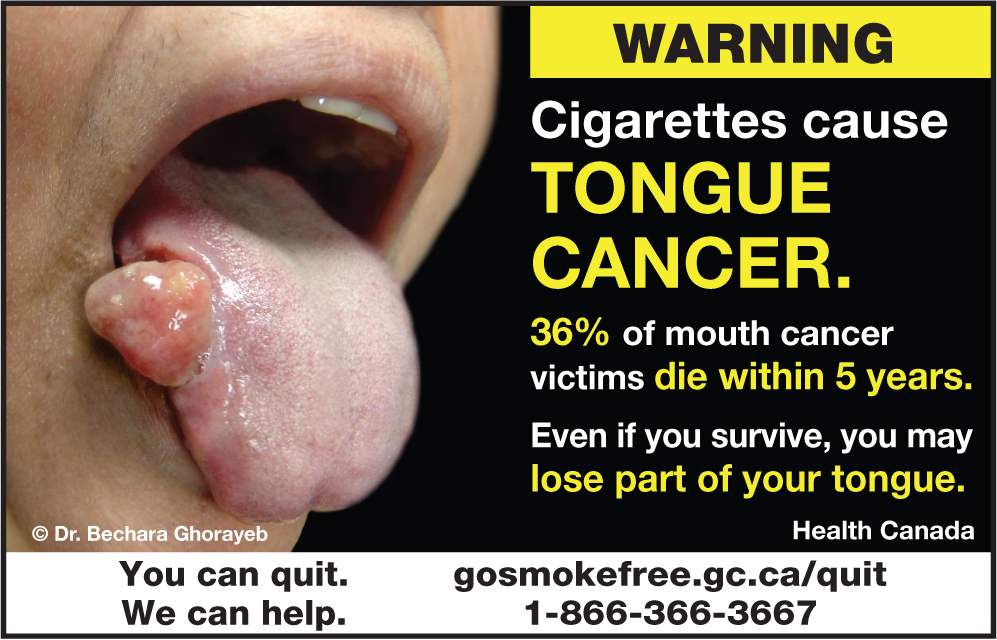WARNING: Graphic images. Some readers may find the photos in this story disturbing.

A bulging lump on someone’s tongue. A big toe that has turned greenish-black from gangrene. A smoker’s infant in hospital, connected to a breathing tube. These are some of the 14 new graphics and photos now starting to appear on cigarette packages to warn about smoking-related harms.
They highlight tongue, stomach and neck cancer as well as gangrene for the first time since Canada led the world in adopting the hard-hitting quit-smoking approach in 2001. Those early images were updated in 2012 with grim patient photos. Plain packaging and requirements for brand names to be written in a standard white font came into effect in 2020.
The latest set of photo warnings also build on various other harms of smoking, including heart attack, brain damage and death from stroke as well as impotence due to reduced blood flow to the penis.
A Health Canada spokesman said manufacturers must ensure they are on packages by Jan. 31, and retailers are required to stock the packs by April 30.
The goal is to slash smoking rates from about 10 per cent to less than five per cent by 2035 as part of a campaign that last year introduced printed warnings, in English and French, on each cigarette, with one saying “poison in every puff.”
Rob Cunningham, senior policy analyst for the Canadian Cancer Society, said evidence from multiple studies worldwide shows the effectiveness of graphic images on cigarette packages, a strategy that dozens of countries have adopted.
“A picture really does have impact. It’s more memorable, it’s more noticeable, it conveys more. It tells the truth about cigarettes,” he said.
One particularly compelling photo, showing an emaciated 42-year Edmonton woman who died of lung cancer, has been repeated from 2012 with a slightly different look, but even that may not deter people from puffing, Cunningham said.
He called for a comprehensive approach that could include higher taxes on cigarettes, more funding for smoking cessation programs and a minimum age of 21 for buyers, as is the case in Prince Edward Island, instead of 18 or 19 depending on the province. Cigarettes should also be sold at fewer retail locations, he said.
“We don’t sell cannabis in convenience stores and gas stations. We shouldn’t be selling cigarettes there.”
Another set of 14 photo warnings is expected to appear on cigarette packages in two years.
Lesley Mulgrew of Regina said she smoked her first cigarette as a 14-year-old on Dec. 22, 1995, when she found half a pack in her sister’s old winter jacket, stashed there for a friend.
“It was gross, really gross,” she said of what she’d considered a “disgusting habit” that ensnared several family members.
The cigarettes lasted for six months, giving way to addiction three years later when Mulgrew’s mother was killed by a drunk driver, she said.
“That night, I smoked a pack and a half, and I’ve been smoking steadily since then.”
The 42-year-old has made multiple attempts to quit because of the high cost of cigarettes and the many health risks that claimed the lives of both of her grandfathers and an uncle.

“To me, smoking cigarettes is like having a best friend that’s always trying to kill you,” she said.
The striking images on cigarette packs have not stopped her from puffing.
“I don’t even see them,” she said. “I don’t consciously look at the picture because I’m so used to them now. When they first put them on yeah, you’re looking at all this gross stuff and it’s like, ewww.”
However, Mulgrew has been cutting the powerful photos from packs for when she is ready to ditch cigarettes.
“I have a little collage that I made so that when I’m quitting smoking I will look at them,” said Mulgrew, adding the latest photos have caught her eye — for now — and she is particularly disturbed by the one showing a gangrened toe.
After trying nicotine replacement therapy (NRT), she now attends an online support group run by Lung Saskatchewan and is determined to stop the habit that her grandfather warned her about as he suffered from emphysema before dying of a heart attack at age 64.
Dr. Peter Selby, head of the Nicotine Dependence Clinic at Toronto’s Centre for Addiction and Mental Health (CAMH), said the striking images pack a lot of information about harms that many people may not be aware of, but they need to be changed regularly to have an impact.
The packs also include a toll-free phone number that connects people to smoking cessation services in their province though the uptake has decreased in recent years, said Selby, who called for more programs because only about 10 per cent of people manage to quit.
“Cigarettes are so addictive that relapse is more the norm that it requires a few kicks at the can before people are successful,” he said.
As of this month, nurses in Ontario can take additional training to prescribe medications to help people butt out.
“We’re trying to reduce the barriers for smoking cessation medication,” Selby said. “And we’re really trying to make sure that these medications should have wide coverage because every two smokers we can help quit, we’re going to save one of them from smoking-related illness.”





Comments